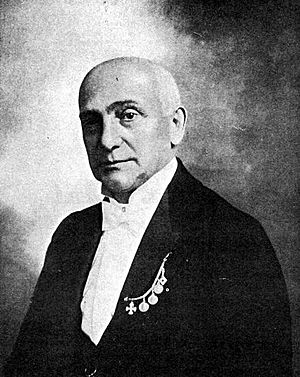Enrico Cecchetti facts for kids
Enrico Cecchetti (born June 21, 1850 – died November 13, 1928) was a famous Italian ballet dancer and mime. He also created his own special way of teaching ballet, known as the Cecchetti method.
Enrico was born in Rome, Italy, right in the costume room of a theater! His parents were both dancers. After a great career dancing in Europe, he moved to St. Petersburg, Russia. There, he danced for the Imperial Ballet and became even better. People loved Enrico for his amazing strength and quickness in his performances. By 1888, many thought he was the best ballet dancer in the world.
After his successful dancing career in Russia, Enrico started teaching. He created important roles like the Bluebird and Carabosse in the famous ballet The Sleeping Beauty. Many famous dancers learned from him, including Anna Pavlova, Léonide Massine, and Vaslav Nijinsky. He also helped stage many ballets, like the well-known 1894 version of Coppélia. This version is still used for most modern performances today. Enrico Cecchetti sadly passed away on November 13, 1928, after collapsing while teaching a class.
Contents
Dancing at the Mariinsky Theatre
In 1887, Enrico Cecchetti performed in St. Petersburg, Russia. Ivan Vsevolozhsky, who was the director of the Mariinsky Theatre, saw him dance. He was so impressed that he immediately hired Enrico as a main dancer for the theater. This was very rare at the time. Usually, dancers had to start at a lower level in a company.
At that time, female dancers often led the way in ballet, especially with pointe technique. Male dancers often played smaller roles, mostly supporting the ballerinas. But Enrico Cecchetti changed this! He began to make male dance roles much more exciting and challenging. He added difficult moves to the male dance parts in the Imperial Ballet's shows.
In 1890, Enrico performed in the amazing production of The Sleeping Beauty. His performance as the Bluebird was a huge hit with the audience at the Mariinsky Theatre. The dance steps for the Bluebird are still very hard for male dancers even today.
Enrico left the Imperial Ballet in 1902 to become the director of the Imperial Ballet School in Warsaw, Poland. His farewell show at the Mariinsky Theatre was a big event. All the top ballerinas of the time performed, and many of them were his students. To honor him, they performed the Paquita Grand pas classique. They added special solo dances for all the ballerinas who were there. This started a tradition of including many different solo dances for ballerinas in this ballet.
In 1919, Enrico Cecchetti also performed in London. He was in the first show of the ballet La Boutique fantasque, playing the part of the shopkeeper.
Teaching Ballet
In classical ballet, dance techniques are often taught directly from person to person. Enrico Cecchetti learned from Giovanni Lepri in Florence. Giovanni Lepri had learned from Carlo Blasis, a very important ballet master. This means Enrico's teaching style connects back to the very first ballet master at the court of King Louis XIV! Enrico also studied with other teachers who had learned from Carlo Blasis.
In 1925, a famous conductor named Arturo Toscanini chose Master Cecchetti to be the director of the La Scala theater dancing school in Milan. Enrico was very sad when his wife passed away two years later. He died in Milan on November 13, 1928.
The Cecchetti Method
Enrico Cecchetti created a special ballet technique that is now called the Cecchetti method. This way of teaching ballet is still very popular with ballet teachers today. It helps dancers become strong and skilled.
After Enrico passed away, some of his students and friends worked together to write down his method. This made sure that ballet teachers could keep using it to train dancers. The Cecchetti Method helps dancers follow strict routines and daily exercises. These exercises help them develop all the skills they need for every kind of dance. Many ballet companies around the world use this training method. This includes The National Ballet of Canada and the Mont Albert Ballet School in Melbourne, Australia.
His Legacy
Enrico Cecchetti taught many famous dancers. Some of his notable students include:
- Anna Pavlova
- Léonide Massine
- Vaslav Nijinsky
- Tamara Karsavina
- Dame Ninette de Valois
- Dame Marie Rambert
- Dame Alicia Markova
- George Balanchine
- Ruth Page
As a dancer and choreographer, he also created and performed roles in important ballets. These include the Eunuch in Scheherazade (1910), Kostchei in The Firebird (1910), and the Magician in Petrushka.
Images for kids
-
Enrico Cecchetti teaching Anna Pavlova in Paris, around 1920.
See also
 In Spanish: Enrico Cecchetti para niños
In Spanish: Enrico Cecchetti para niños
- List of dancers
Sources
- History of Enrico Cecchetti at Cecchetti USA




